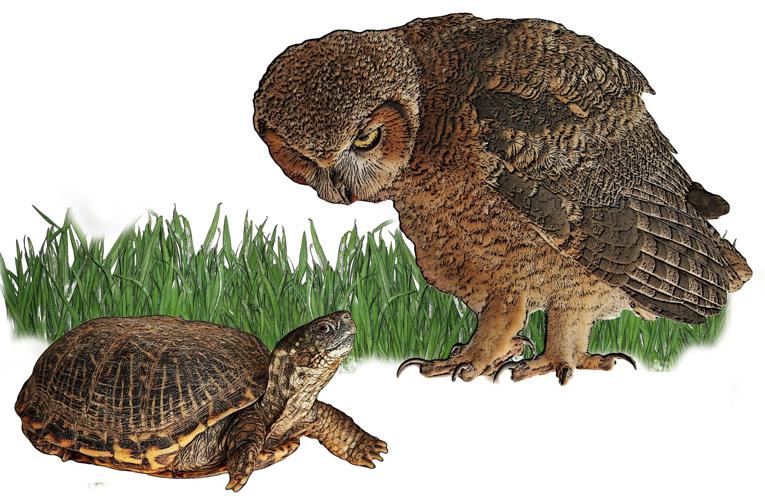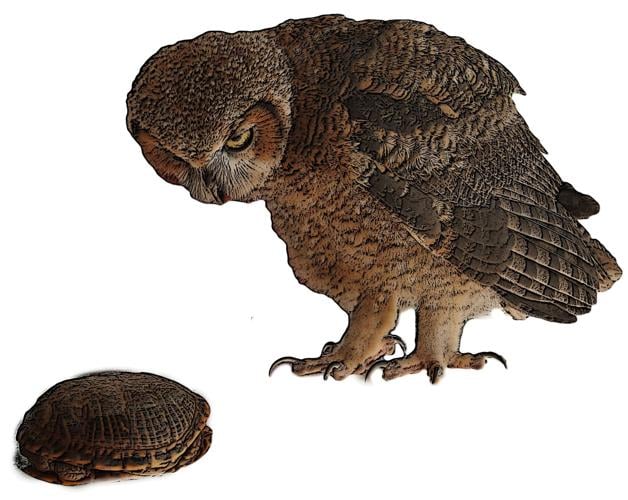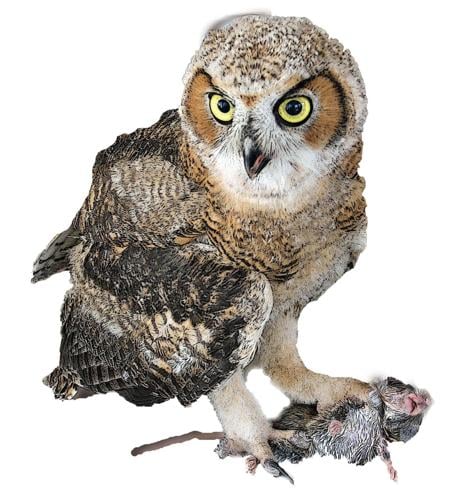A wise old owl lived in an oak
The more he saw, the less he spoke
The less he spoke, the more he heard
Why can't we all be like that wise old bird?
Why be a turtle if you could help it?
A barely mobile rock, a four-legged helmet,
Her track is slow and graceless,
Like dragging a packing case places.
Boo was a young, great horned owl. He had learned to fly and was out exploring his world when suddenly he saw a rock move. “Aha!” thought Boo, “There must be something under that rock - something good to eat. Boo was always hungry, and he knew that everything that moved seemed to be edible; in fact, he had just feasted on two giant hairy scorpions, as well as a long-nosed snake.
Boo glided down next to the rock that had moved, but all he saw was a rock. He pecked at it with his beak and grabbed it with his sharp talons, but it still felt just like a rock.
Wait a minute! The rock moved again. Boo was startled and stepped back. “Whoa, what kind of rock is this?” he asked. Suddenly a head, four legs and a tail emerged from the rock.
“You are not a very smart owl. I am not a rock; I am a box turtle” said a voice. “My full name is the ornate or desert box turtle, Terrapene ornata, but you can call me BT.”
Boo: Glad to meet you, BT. I am a great horned owl, Bubo virginianus, but you can call me Boo. You seem to be a nice animal, and I am sorry that I was thinking of eating you.
BT: I am used to having animals try to eat me, but my shell is good protection. You can see scars on my shell from a young coyote that chewed on me for quite a while until it decided to try and find something softer to eat, like a pack rat or rabbit.
Boo: That sounds like good protection.
BT: It is if we can survive for the first 5-7 years until we get larger and our shells harden. We burrow in the ground to protect ourselves from the weather and predators.
Boo: Seven years - that sounds like a long time. I grow up in a hurry. It’s only been six weeks since I hatched, and I am already learning how to fly. My parents will feed me for several more months, and then I will be on my own. If I am lucky, I can live almost 30 years.
BT: That’s not long! If I am lucky, I can live for more than 100 years.
BT: We take life easy you know, hibernate from early October until mid-May. When it gets too hot, we will bury under some cool soil in the shade and take a nap.
Boo: Is hibernating like sleeping?
BT: It’s like a very deep sleep. We don’t eat, and our heart rate drops from 10-12 beats per minute to nearly 0 during the coldest part of the winter.
Boo: Well, we don’t hibernate and we hardly sleep. Our heart rate is about twice the heart rate of humans at around 140 beats per minute. We sleep during the day and the middle of the night, but we become alert with the slightest sound. Our sense of hearing is so good that we can detect a mouse stepping on a twig from a distance of 75 feet! We hunt just after sundown and just before sun-up. Other species of owls hunt in the darkest part of the night. Otherwise, they may become our dinner.
We even have three eyelids. We have a normal upper and lower eyelid - the upper closing when we blink, and the lower closing when we sleep. The third eyelid is called a nictating membrane, which is a thin layer of tissue that closes diagonally across the eye, from the inside to the outside. This cleans and protects the surface of the eye.
BT: We only have one set of eyelids; snakes don’t have any.
Boo: What do you eat?
BT: I am an omnivore. I like insects, worms and many kinds of vegetation, including cactus pads. I will sometimes come across the carcass of a dead animal and then I have a real meal.
Boo: Yuck! I prefer my meals fresh. I like to hunt at night. When I hear a small animal running through the grass, I silently glide up and grab it with my powerful talons. If it is large, like a rabbit, I tear it apart; small animals, like mice, I swallow whole.
Boo: It’s been very nice talking to you and next time we meet I won’t try to eat you. I have to go now I just heard a pack rat in the grass and I want to invite him for dinner.
BT: (thinking he was a pretty smart owl but not very experienced) Goodbye Boo and Good Luck!
2 Sidebars:
Box Turtle Info
One of the major threats to box turtles is landscape changes to their habitat, such as large-scale development and the creation of roads that cause habitat fragmentation and isolate populations. Other threats include mortality from automobiles and collection from the wild. Box turtles are often encountered crossing roads in suburban and rural areas in southeastern Arizona, especially during the monsoon season. Unfortunately, many people mistakenly believe that a box turtle they encounter on the road can be helped by bringing it home. However, bringing a box turtle home means it must always remain in captivity, because a captive turtle can never be released back into the wild. Please leave wild box turtles in the wild; not only is it illegal to collect them, it hurts wild populations.
The turtle mates in the spring or fall. The female can store sperm and produce several egg clutches over several years from a single mating. She may also effectively store a clutch, awaiting optimum conditions for laying the eggs. She digs a shallow nest in moist, well-drained soil, producing her clutch of two to eight eggs in mid- to late-spring. She then abandons the nest, leaving the coming hatchlings to fend for themselves. The turtle, with its several siblings, hatches during midsummer. About the size of a thumb tip and a product of parental abandonment, it may remain close to its comforting birth nest through its first fall and winter season. If it survives the trials of hunger, predation and seasonal extremes, it will reach sexual maturity, its shell fully hardened, at seven to 10 years of age. With good luck, it may live several decades. Under ideal conditions, live for a century or more.
Great Horned Owl info
The Great Horned Owl is a fierce hunter that prefers the sit-and-wait approach. Watching from a perch above, the owl will quietly swoop down on passing prey and seize its meal. The talons of this owl can close down on its prey with the force of almost 30 pounds. Its wing feathers are comb-like with a soft fringe that helps reduce the sound of air rushing through them; as such the Great Horned Owl is more apt to glide than flap its wings. Such a maneuver makes it almost impossible for prey to hear it advance.
The first year of life is the hardest to survive for Great Horned Owls and depends heavily on food abundance. Once they reach adulthood survival rates are very good. They have no natural predators as adults, so most owl problems are human-caused: hit by car, shot, electrocuted, caught in barbed wire, poison, etc.
The oldest known wild Great Horned Owl was 28-years-old.
Females are bigger and heavier than males. The largest Great Horned Owls males weigh from 2-3 lbs. and females 3-4 lbs.
Great Horned Owls eat almost anything that moves, and will even eat carrion if need be. They are carnivores, however and don't eat seeds, bread or anything other than meat.
Like other owls, Great Horned Owls eat fur, feathers, and bones along with the meat and organs. And like other owls, their stomach acid isn't acidic enough to digest the bones, fur and feathers, so they throw up pellets once a day that consist of these indigestible goodies.
Great Horned Owls, like other owls, are clueless about building nests. They use other available structures to nest in, which include stick nests of hawks and crows, small caves, ledges or crevices on cliffs, bridges, power lines, barns and old buildings and balconies.
They most often lay 2-3 eggs, with incubation usually starting when the first egg is laid. The female develops a brood patch and does the incubation, which lasts 30 or more days.
Owlets grow very fast and eat like pigs. They are ready to start "branching" out onto adjacent branches or the side of the nest sometime after six weeks of age, even though their head and bodies are still fuzzy. They aren't flying well until 10-12 weeks of age.







